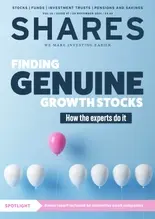
- H1 revenue down 18%
- Free cash flow improved
- CEO sees a ‘faster and more agile’ ASOS
Sales at struggling online fast fashion retailer ASOS (ASC) remain in freefall, having plunged by 18% in the first half to 3 March 2024 amid intense competition and the ongoing squeeze on fashionistas’ purchasing power and as ASOS focused on reducing stock levels to boost profitability.
So why did shares in the fallen fashion group rally 10% to 380p in early dealings on Tuesday?
Well, there was relief as ASOS left full year revenue guidance unchanged, albeit for a worrying 5% to 15% sales decline, and insisted it will deliver positive adjusted EBITDA (earnings before interest, tax, depreciation and amortisation) for the year.
FIRST HALF SALES PLUNGE
The website for fashion-loving 20-somethings reported an 18% first half sales plunge and reiterated full year revenue guidance for a 5% to 15% decline, although Shore Capital warned the result could be closer to the lower end of guidance ‘unless there is a notable reverse trading performance’ in the second half.
ASOS, which owns Topshop, Topman and Miss Selfridge, enjoyed a boom during the pandemic but has struggled to grow post-Covid.
Consumer shopping habits have changed – after the heyday of Covid when everyone was ordering goods because they were bored at home, now there is more consideration made to purchases, something that’s been exacerbated by the cost-of-living crisis.
Heightened competition from the likes of Shein has also presented shoppers with cheaper alternatives.
Management has cast 2024 as a transition year as it focuses on speeding up processes, launching new collections and shifting excess stock.
Encouragingly, free cash flow improved by £240 million year-on-year in the first half thanks to improved stock efficiency and reduced inventory and ASOS ended the period with more than £330 million of cash balances.
This year, the embattled online retailer expects to pare inventory back to pre-Covid levels and reduce net debt thanks to positive cash generation.
WHAT DID THE CEO SAY?
CEO Jose Antonio Ramos Calamonte insisted ASOS is becoming ‘a faster and more agile business’, aided by the work to speed up processes to ‘deliver the fashion, quality and prices that our customers want, when they want it. I’m excited by the performance of our new collections, while we have also made great progress in monetising inventory that built up over the pandemic and in improving the core profitability of our operations.’
EXPERT VIEWS
AJ Bell investment director Russ Mould commented: ‘ASOS’ ongoing sales decline is extremely worrying. It suggests the choice of products on offer is completely wrong or shoppers are simply going elsewhere to buy their clothes, potentially Shein or Primark as they have similar customer demographics and cheaper price points.
‘However, it’s worth noting that ASOS has been sitting on a mountain of unsold clothes and the priority has been to clear this inventory. Naturally, if it is slashing prices on this stuff, customers might be tempted to buy the discounted goods rather than full-price items. As a result, it is difficult to get a true picture of sales trends as the figures continue to be distorted by the inventory run-down.’
Mould also noted that ‘retail vulture’ Frasers (FRAS) increased its total interest in ASOS last week to 27.1% via a mixture of shares and financial instruments.
‘Frasers likes to pounce on the weak and vulnerable and ASOS certainly fits the bill,’ said Mould. ‘As always with Frasers, a takeover is unlikely unless ASOS goes into administration, which doesn’t appear to be on the cards at the moment. Instead, the weaker ASOS gets, the bigger the power Frasers has as a shareholder to try and strike collaborative partnerships.’
Julie Palmer, partner at Begbies Traynor (BEG:AIM), said ASOS is still ‘a shadow of its former self and the latest update from the struggling online retailer highlights the challenge it still faces.
‘In a period that includes Christmas and the New Year, sales fell by nearly a fifth, worse even than their cautious guidance at the last set of results. The whole retail sector had to grapple with a weak consumer backdrop and an unexpectedly mild winter, but it’s still not pretty reading this morning.’
DISCLAIMER: Financial services company AJ Bell referenced in this article owns Shares magazine. The author of this article (James Crux) and the editor (Martin Gamble) own shares in AJ Bell.




